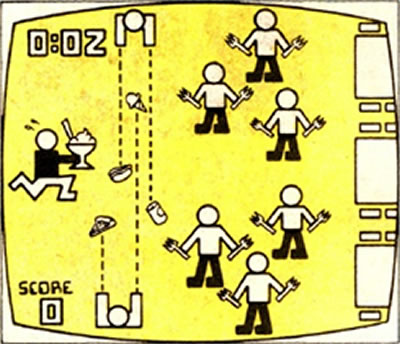
When even the cat disapproves, it’s a sign you’re into some really messed-up stuff.
This article also appears in The Adventures of Accordion Guy in the 21st Century.

When even the cat disapproves, it’s a sign you’re into some really messed-up stuff.
This article also appears in The Adventures of Accordion Guy in the 21st Century.

Mark Xtreme Labs as yet another Toronto-based startup that got acquired. The California-based software company Pivotal bought them for $65 million, and Xtreme will remain in Canada as Pivotal Labs.
I first set foot in Xtreme Labs when I worked for Microsoft, in my role as Windows Phone Champ, and I was impressed. This was in their old space, falling distance from Toronto’s financial district, with about 150 or so people packed into two floors of an office building. They’re one of the few companies I’ve seen up close that do extreme programming by the book, from stand-up meetings to all pair programming, all the time, to continuous integration and build monitoring — all the stuff that people at XP meetups talk about but so few do. The developer bullpen on their lower floor was packed with young people, many still fresh from graduation, but all of them with smarts, ambition, and gusto. I’ve never seen even a hint of their being afraid to try new things or take on a challenge.
Congrats, Pivotal and Xtreme Labs!
Click the photo to read the issue.
I had to look up the name of the guy on the cover. He’s one of the kids from Little House on the Prairie.
In the early 1980s, video game arcades and the first generation of consoles that could play games that they weren’t hard-wired for were runaway hits. In response came the first of the videogamer magazines, including Blip, a short-lived effort by Marvel Comics.
Most of the content for these gaming magazines was pretty sad compared to the in-depth sort of stuff we’ve come to expect in the age of The Escapist — a lot of it was filler written hastily in the pursuit of selling advertising space. If you don’t believe me, check out this collection of old Blip magazine scans on Scribd, collected by one “CubemanPDX”.
A common bit of comedic filler that appeared in just about every videogame magazine of that era was “Wacky game ideas we’d like to see”, or as Blip called them, “Games we’ll never see”. Here’s such an article from the February 1983 edition of Blip:

These games would’ve been ridiculous ideas in the 1980s, when the number of videogames out there numbered in the few hundreds, processing power was scarce, and getting an audience for your game required either a relationship with an arcade machine manufacturer or a software publishing house. In the world of smartphones, vast app marketplaces, the internet, and the long tail, these ideas could be turned into some interesting games.
Here are close-ups of images showing the two ideas from the articles, with the descriptive text…

You’re in the school cafeteria, and there’s only one chocolate pudding left. You want it, but so does everybody else in the place. Fight them all off and get safely to a table to win the game.

You’re watching TV, and your mother says she needs maraschino cherries and worcestershire sauce for dinner. A commercial comes on — and the timer begins a countdown. Dodge traffic, dogs, and little kids to reach the store, make the purchases, and get back before the commercial break ends.
(You may need to re-jig this one slightly. Do kids today know that “boob tube” refers to TV? Do commercial breaks matter as much in the age of DVRs, Netflix, and other goodies that disrupted TV as we knew it in the 1980s?)
They’re (Almost) All Dirty: The State of Cheating in Android Benchmarks is a pretty damning headline, but that’s only the start. In the article with that title, Anand Lai Shimpi (AnandTech’s namesake) and Brian Klug take a look at how various OEMs try to make themselves look better by detecting the execution of well-known benchmarking applications and in response tweaking the CPUs to run at full speed and to not drop into power-saving mode. Yes, you could run all the cores on a mobile device CPU at full speed constantly for all apps, but that isn’t done because doing so is such a power drain that you’d be recharging a half-dozen times a day. This practice of running all cores at full speed when a benchmarking app is detected is at best the equivalent of pretending to look really busy when the boss is walking by; at worst, it’s lying to the consumer.
In their article, they posted a table showing a number of current Android Devices and the benchmark tests for which they cheat. I love the title of their table, which I’ve copied and pasted below: I Can’t Believe I Have to Make This Table:
| I Can’t Believe I Have to Make This Table | |||||||||||
| Device | SoC | Cheats In | |||||||||
| 3DM | AnTuTu | AndEBench | Basemark X | Geekbench 3 | GFXB 2.7 | Vellamo | |||||
| ASUS Padfone Infinity | Qualcomm Snapdragon 800 | N | Y | N | N | N | N | Y | |||
| HTC One | Qualcomm Snapdragon 600 | Y | Y | N | N | N | Y | Y | |||
| HTC One mini | Qualcomm Snapdragon 400 | Y | Y | N | N | N | Y | Y | |||
| LG G2 | Qualcomm Snapdragon 800 | N | Y | N | N | N | N | Y | |||
| Moto RAZR i | Intel Atom Z2460 | N | N | N | N | N | N | N | |||
| Moto X | Qualcomm Snapdragon S4 Pro | N | N | N | N | N | N | N | |||
| Nexus 4 | Qualcomm APQ8064 | N | N | N | N | N | N | N | |||
| Nexus 7 | Qualcomm Snapdragon 600 | N | N | N | N | N | N | N | |||
| Samsung Galaxy S 4 | Qualcomm Snapdragon 600 | N | Y | Y | N | N | N | Y | |||
| Samsung Galaxy Note 3 | Qualcomm Snapdragon 800 | Y | Y | Y | Y | Y | N | Y | |||
| Samsung Galaxy Tab 3 10.1 | Intel Atom Z2560 | N | Y | Y | N | N | N | N | |||
| Samsung Galaxy Note 10.1 (2014 Edition) | Samsung Exynos 5420 | Y(1.4) | Y(1.4) | Y(1.4) | Y(1.4) | Y(1.4) | N | Y(1.9) | |||
| NVIDIA Shield | Tegra 4 | N | N | N | N | N | N | N | |||
They also write (the emphasis is mine):
We started piecing this data together back in July, and even had conversations with both silicon vendors and OEMs about getting it to stop.
With the exception of Apple and Motorola, literally every single OEM we’ve worked with ships (or has shipped) at least one device that runs this silly CPU optimization.
It’s possible that older Motorola devices might’ve done the same thing, but none of the newer devices we have on hand exhibited the behavior. It’s a systemic problem that seems to have surfaced over the last two years, and one that extends far beyond Samsung.
Kudos to Apple and Motorola for not playing this game, and to the other OEMs: cut it out. Even if take away the issue of right versus wrong, there’s still a coldly Macchiavellian, pragmatic reason to not do so. The performance gains you get from rigging benchmark tests in this fashion are below 10%, and they’re not worth the bad press you’ll have to live with for the next little while.
Ladies Learning Code, who describe themselves as “a Toronto-based not-for-profit organization that runs workshops for women (and men) who want to learn beginner-friendly computer programming and other technical skills in a social and collaborative way” are celebrating their second birthday tomorrow night, Thursday, October 3rd at 7:30 p.m. at Hotel Ocho (195 Spadina Avenue, just over a block north of Queen). They’re throwing a fundraising party, and if previous get-togethers of theirs are any indication, this one should be a blast. If I weren’t Tampa, I’d be going to the party.
Tickets are $25.00 for early birds (you’ve got until about 11:00 p.m. on Wednesday, October 2nd to grab those) or $35.00 for not-so-early birds — they’re available at the event’s EventBrite page.
Want to know more about what Ladies Learning Code does? Check out this recent video by XDA Developers:
Reg Braithwaite and his book, JavaScript Allongé.
Reg Braithwaite’s book, JavaScript Allongé, which shows you how to make the most of JavaScript’s objects, functions, combinators, decorators, and quirks, is now free in both the copying and costs senses of the word. He’s put it under a Creative Commons Attribution-ShareAlike 3.0 Unported Licence, which means you can share, remix, and even make commercial use of it. He’s also saved you twenty dollars and made it available for free, and you can read it online as well as get the Markdown source.
He writes:
The book is barely a blip on the publishing scene when we judge JavaScript Allongé against titles like “Get your dream job as a Web Developer in 21 Days!” Those kinds of books sell bythe container-load. But nevertheless, people read it and tell me that it levels them up, and AFAIC that is a success. And as a bonus, I got my dream job, and now it’s time for me to walk the freedom talk. I’m now working for a company that is trying its dambdest to help every single programmer on the planet write more software and better software. And we give something away, crossing our fingers that more software and better software will be a good thing and that we’ll make enough to keep doing what we do.
I believe in this. That’s why I write, and that’s why I work at GitHub. And you helped me get here.
If you want to take your JavaScript to the next level, JavaScript Allongé is the book for you. Reg does a lot of deep thinking about how to write better code, and there’s a lot of that thinking in his book. Do yourself a favour — especially since it’s free now — and read it!
I like CollegeHumor’s graphic of the Seven Deadly Sins, with each sin rendered using the logo of the a suitably-matched site:

This article also appears in The Adventures of Accordion Guy in the 21st Century.